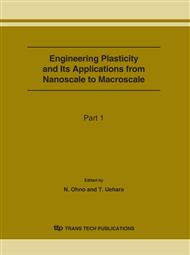p.713
p.719
p.725
p.731
p.737
p.743
p.749
p.755
p.761
Hot Forging Comparative Analyses by Using a Combined Finite Element Method
Abstract:
In this paper, single action die and double action die hot forging problems are analyzed by a combined FEM, which consists of the volumetrically elastic and deviatorically rigid-plastic FEM and the heat transfer FEM. The volumetrically elastic and deviatorically rigid-plastic FEM has some merits in comparison with the conventional rigid-plastic FEMs. Differences of calculated results for the two forging processes can be clearly seen in this paper. It is also verified that these calculated results are similar to those of the conventional rigid-plastic FEM in comparison with analyses of the same numerical examples by the penalty rigid-plastic FEM.
Info:
Periodical:
Pages:
737-742
Citation:
Online since:
June 2007
Authors:
Price:
Сopyright:
© 2007 Trans Tech Publications Ltd. All Rights Reserved
Share:
Citation:


